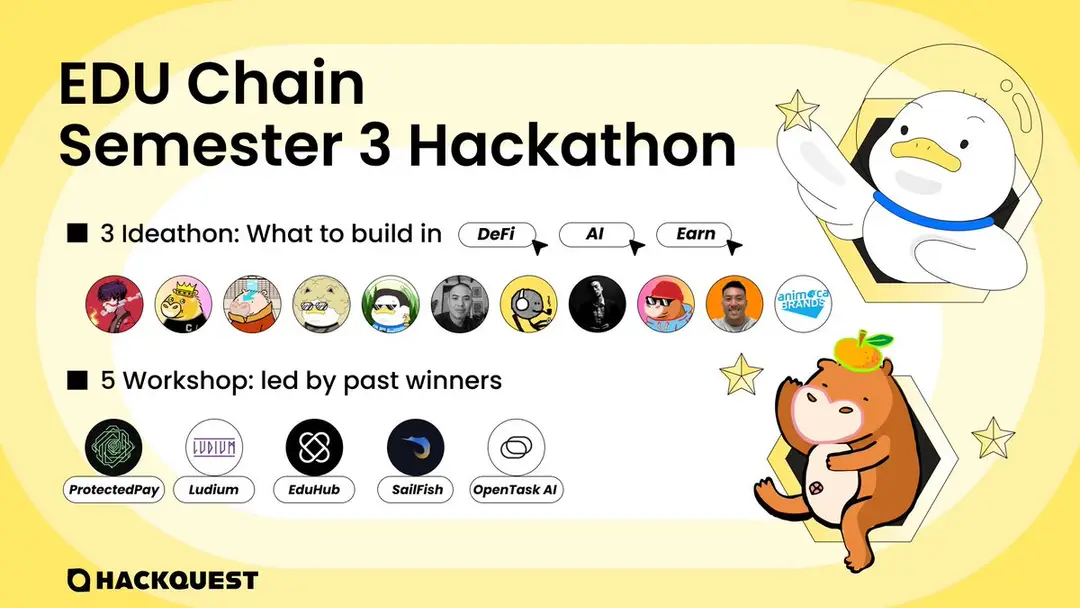Back
EDU Chain Semester 3 Hackathon Ideathon 2: What to build in AI now Recap
Events
By HackQuest
Mar 18,20254 min read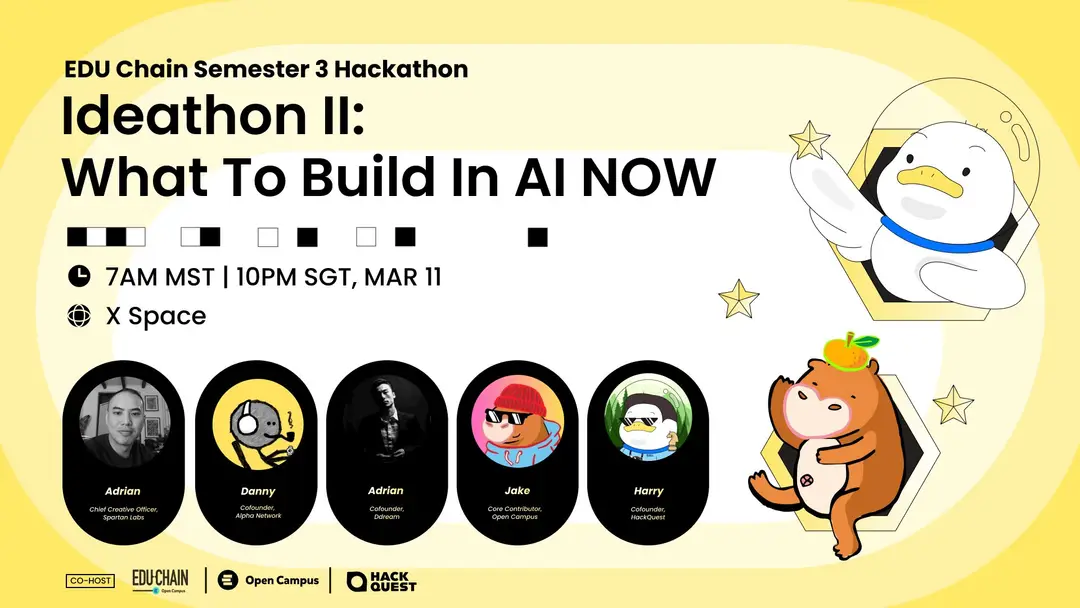
With the launch of the EDU Chain Semester 3 Hackathon, HackQuest hosted an insightful Ideathon featuring experts from Spartan Labs, Alpha Network, Ddream, OpenCampus, and HackQuest, including Adrian Lai, Danny, Adrian, Jake Hughes, and Harry Zhang, to explore AI innovation opportunities within the EDU Chain ecosystem. The session covered the current AI landscape in Web3, challenges faced by AI builders, and practical approaches to developing successful AI projects.
Panelists discussed how AI is rapidly gaining mainstream adoption, with 80% of companies now using AI tools and 56% of employees incorporating them into daily workflows. They highlighted the shift toward agent-based AI systems that can autonomously interact with various tools and services through standardized protocols like MCP (Model Context Protocol). The speakers shared insights on "vibe coding" - a new development approach where applications are built primarily through AI prompting - noting that some YC startups now have 95% AI-generated codebases.
The discussion emphasized practical development strategies, including breaking down traditional processes into standard operating procedures before implementing AI workflows, starting with minimal viable products focused on core features, and leveraging existing tools rather than building from scratch. Speakers showcased successful EDU Chain AI projects like OpenTask AI (connecting AI-skilled freelancers with employers), EDU-GPT (an AI-powered blockchain explorer), and Assetly (an AI portfolio manager).
Participants were encouraged to join the EDU Chain Semester 3 Hackathon with its 70k prize pool for AI projects, focusing on solving real educational problems for students, teachers, and institutions. The panel provided specific advice for hackathon success, including thorough documentation, polished UIs, concise demos, and clear articulation of project vision. They emphasized the importance of understanding the EDU Chain ecosystem needs and leveraging resources like the OpenCampus Discord community and incubator program to transform promising hackathon projects into sustainable businesses.
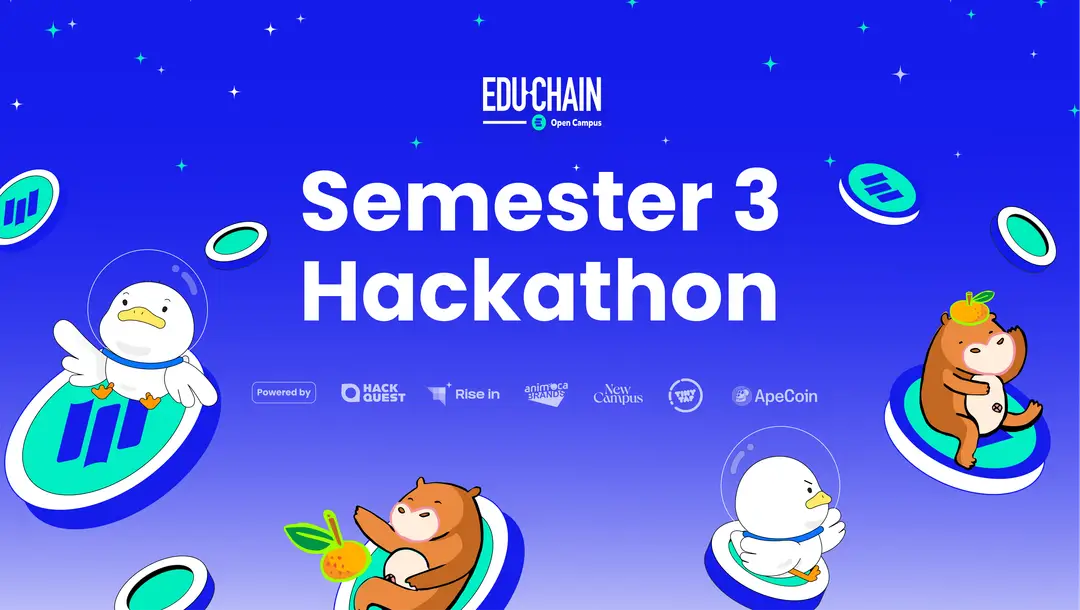
Key Takeaway
●AI Agent Revolution: 2025 is poised to be a breakthrough year for agent AI in Web3, with frameworks like Model Context Protocol (MCP) standardizing how LLMs connect with tools and services, enabling more sophisticated autonomous applications in education and finance.
●Interactive Learning Experiences: The evolution from static content to interactive AI-powered educational tools is creating new opportunities for language learning, early childhood education, and specialized subject matter instruction through conversational interfaces guided by educational goals.
●Vibe Coding Democratization: The emergence of "vibe coding" through AI tools like Cursor and Windsurf is democratizing development, allowing non-technical founders to build full-stack applications through prompting alone, with some YC startups having 95% of their codebase generated by AI.
●Workflow-Based Development: Successful AI projects require breaking down traditional business processes into standard operating procedures (SOPs), then creating specialized workflows for each component that can be connected into a cohesive system, balancing task complexity with AI capabilities.
●Minimalist MVP Approach: The most effective MVPs focus on a single core feature that works flawlessly rather than multiple half-implemented features, with the goal of gathering initial user feedback rather than immediate revenue generation or traction.
●Education-Focused Use Cases: EDU Chain is fostering innovation in AI applications specifically for education stakeholders (students, teachers, institutions), with successful projects like OpenTask AI connecting AI-skilled freelancers with employers, and EDU-GPT making blockchain data more accessible through conversational interfaces.
●Hackathon Success Formula: Winning hackathon submissions combine working prototypes, clear documentation, polished UIs, and concise demos (under 10 minutes), with judges particularly valuing projects that solve real educational problems while potentially driving attention and TVL to the EDU Chain ecosystem.
Introduction
Danny: I'm Danny from Alpha Network. We are building what we call the AI execution layer for Off-Web3, Azure Chain and Multi-Chain as well. We are part of the OpenCampus Incubation Cohort Group.
Jake: I'm Jake, one of the core contributors to the OpenCampus DAO, working a lot at the moment on the EDU chain, and I also have a role at Animoca Brands as marketing manager. I've been with the OpenCampus team for around 18 months, so I've been in the privileged position to see the ecosystem grow. We first talked about EDU chain probably about a year ago for the first time, and it's been an amazing journey from the kind of idea stage right till now, where we've got real builders building real products on EDU chain. I'm very excited for today's session, where we're going to dive into some ideas around AI products that we can have come to life on EDU chain. I think it's a really exciting space, particularly the crossover from AI and education.
Current AI Landscape in Web3
Adrian (Ddream): I think the current AI landscape is developing so fast, and I definitely think 2025 will be a big year for agent AI. There are so many open source workflows to use, such as Comfy UI or DeFi, so users can quickly use something, use some workflow at their willing, so they can test out their idea easily. I think 2025 will be the big year for agent AI.
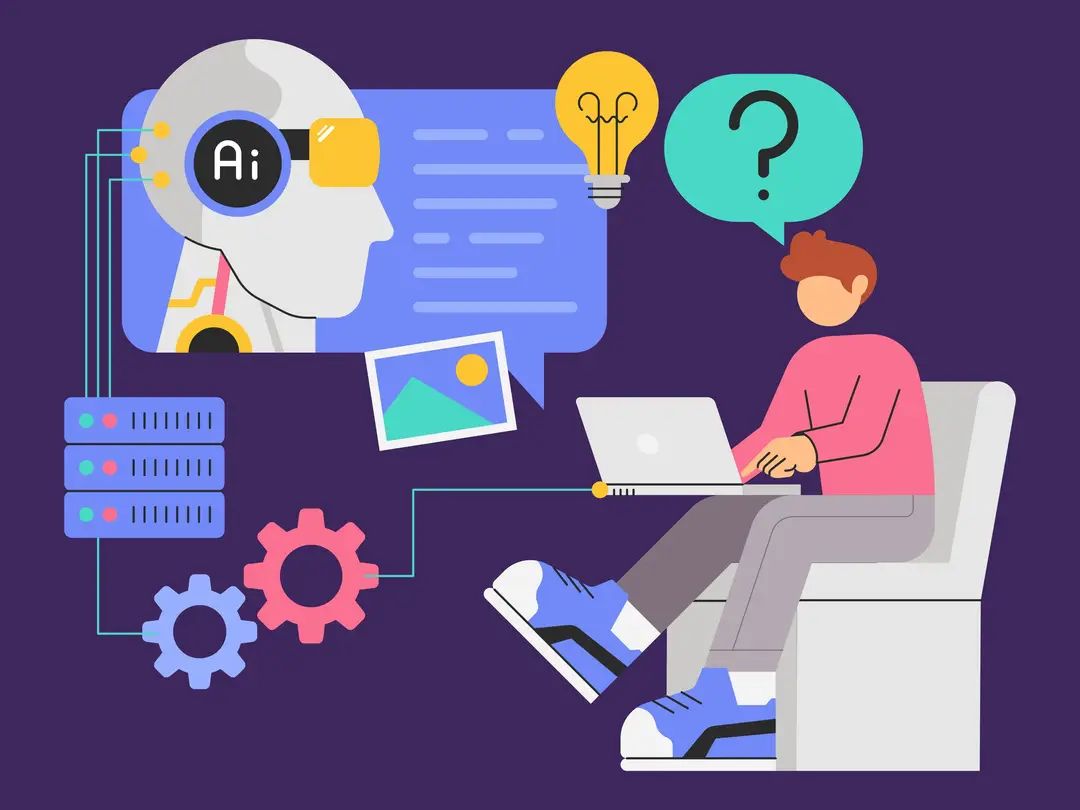
Source: Otter.ai
Danny: Last year would definitely be a big year for AI plus crypto. We see the innovation spanning from LLMs to data infrastructure. Many of them already went public. We see a good performance of them. Great ideas are pretty much emerging or appearing alongside a wide range of practical use cases across those industries.
A notable trend is most of the popular projects in the market issued tokens while they are still in the MVP stage or even pre-product stage. While some AI projects achieve the short-term token market fit (TMF), they often gain traction in speculative markets. They may lack strong long-term product market fit, low TMF. This raises concern about the sustainability of those projects.
I see the outstanding AI project called Hyperbolic, which is an open access AI cloud platform that democratizes AI infrastructure by making GPU computing more accessible, affordable, and scalable. This is what they are saying at the website. I see a good trend and good project market fit of decentralized AI compute power. They also have a clear monetization opportunity as well.
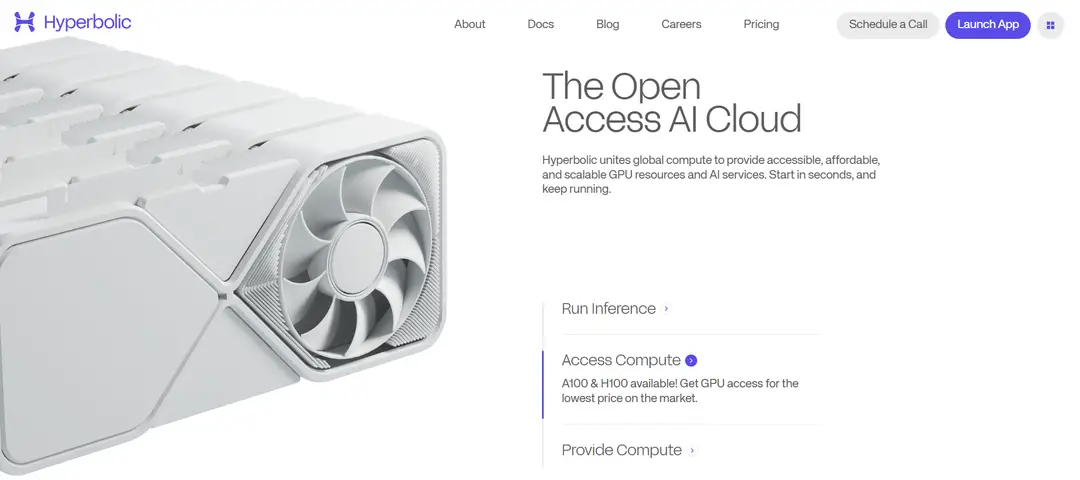
Source: Hyperbolic
Jake: If you look at the landscape as a whole, I think if you look at the tech industry, the three big sectors that have got the most mind share at the moment is AI would be number one, closely followed by blockchain and crypto. And then also electric vehicles have to be in that big three. That's where the greatest mind share is. It's probably where most of the political power and talk is focusing on as well.
AI is definitely dominating a lot of that attention, both from a user perspective, also from an investor perspective. We are pretty much at the tipping point or past the tipping point where AI is only used by early adopters and now it's being used by a mainstream audience. I was looking at some stats before this and around 80 percent of companies use it in some way now, and about 56 percent of employees use it every day in some aspects. That's a really good signal that AI tools and products are getting mainstream adoption.
Because of this, we're going to continue to see lots of developers innovating within the AI space. I think we're going to continue to see that most tech VC money is going to be pumped into AI products. For example, NVIDIA, the company that's building the picks and shovels for AI, has been the best performing stock and this is going to be ingrained into those VCs' minds.
If you look at big AI companies like OpenAI, Anthropic, Grok, they're all competing to be the number one product to build that kind of monopoly on the space where they get the most users. That race is happening. That also leaves an interesting bit of room for some of the builders that will be listening today that are building decentralized AI products when those big companies are building pretty centralized products and competing for a monopoly on the market. I think there is a genuine fear from users of giving away all of their data to these centralized authorities. So there is space for builders like us to build some alternatives to that.
Adrian Lai: I'm Adrian, one of the leads at Spartan Labs, which is the venture studio and product lab of Spartan Group. We are very heavily immersed in the AI space right now. We have built a couple of agents ourselves and incubating some portfolio companies that are also doing agents.
In general, what I'm into lately are AI agents and also recently MCPs. The opportunity for AI and education in particular, especially with agents, is that AI is very good at explaining complex data or synthesizing information. So with that, it opens up a lot of design patterns, including creating content that can better explain complex concepts or including learning coding. Vibe coding is becoming a thing right now.
Challenges AI Builders Face
Adrian (Ddream): I think from my understanding, building an AI product is really thinking about AI plus something. AI could be a very useful tool, but what really matters is the second part - the business you want to add into AI. The biggest challenge now is how well you understand your business.
You need to turn those traditional processes into something we call standard operating procedure (SOP). My understanding about building the workflow and connecting workflow is exactly what is the most important thing building an AI project. As long as you can divide your traditional progress into pieces and figuring out how to build the workflow for each core component, you can easily connect those components.
Take our product as an example. Our platform allows users to create a DAO game and ATOMA game from scratch very easily using our tool. The biggest challenge for us is figuring out the traditional DAO game creating process and what's the most important thing for each step. We need to figure out the most important thing for each step and how we can create a workflow to accomplish the task for each component.
To conclude, the most challenging thing is figuring out the SOP of your traditional business and figuring out how to create the workflow for each component.
How EDU Chain Creates Opportunities for AI Developers
Jake: There are a number of different things we're doing to support AI builders on EDU Chain. The core thesis for us to support AI builders is to put up some prize money in the hackathons that we run ourselves or that we sponsor. For the semester three hackathon that's live right now, the AI track has up to 70k dollars in prize pool that will be distributed across up to 10 winners.
We also have a hackathon live right now with the Imperial College in London. This is a hackathon specifically for student AI builders. We've put up a small prize pool there to attract the best AI developer talent.
All of our hackathons throughout the year will most likely have an AI track so that we can attract the best builders there. Another way that we like to support not only AI builders, but any builder on EDU Chain is with our incubators program. This is a 12-week program that aims to turn developers into founders and also build traction for the products that they've built for these hackathons. Developers will get connected with industry experts as mentors, and there'll be a bunch of different workshops to coach these developers into getting more traction for their product.
Ideation: What to Build on EDU Chain
Danny: If you are focusing on education, DeFi, plus AI, such as DFAI, or maybe there's going to be like Edu-AI, which are also the narratives of EDU Chain, would be more likely to hit your target users when you are building on EDU Chain. When you are building with AI applications, a very important skill is how to use AI to code for builders. If you are building with AI applications or anything related to AI, this would definitely differentiate good builders from normal very clearly.
Adrian (Ddream): My focus is more on the AI plus gaming side. Just like what happened in the internet era, we've been through from text to image and to the video. Starting from ChatGPT, we are in the AI text era, but it's interactive. Similarly, due to the capability of Comfy UI, we can control the parts of the image in detail. We are now into something I call interactive image plus text.
That's what we are trying to build about the DAO game is interactive text plus image, kind of like a game, but I think there will be something similar and we can build under the interactive image section.
Adrian Lai: An MCP essentially stands for model context protocol. When you think of an AI agent, it's essentially an LLM that has access to tools. When you have an LLM that has access to tools, you can configure it in a way that it can interact with its own environment.
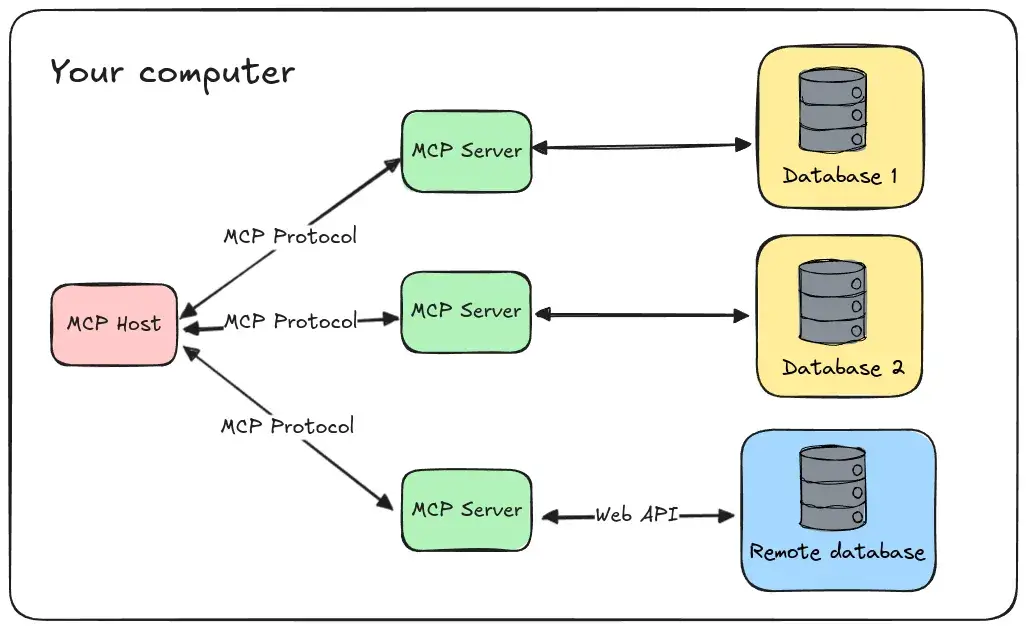
Source: Medium
Traditionally, the way you would do that is through APIs and you just have to plug in and connect those APIs into the AI agent that you're building. But with model context protocol (MCP), it standardizes the APIs, making it easier to connect different tools and services into your LLM. For example, if you're using Claude, now you can allow Claude to browse the internet through a one-click interaction. Whereas before you would have to go and find a tool that allowed Claude to browse the internet and then set that up and code it. Now you can do it with no code or in a much easier format.
Vibe coding, which I've been doing a lot, is essentially coding with Cursor or with Windsurf or another IDE coding tool, but just purely through prompting. You are essentially just setting a brief, setting some rules, and then developing an app through purely prompting. You can build full stack apps with blockchain, smart contract integration, database integration. The one we're working on is called Superfun (superfun.xyz). The app was pretty much vibe coded in a month. It's a full stack app that looks pretty good.
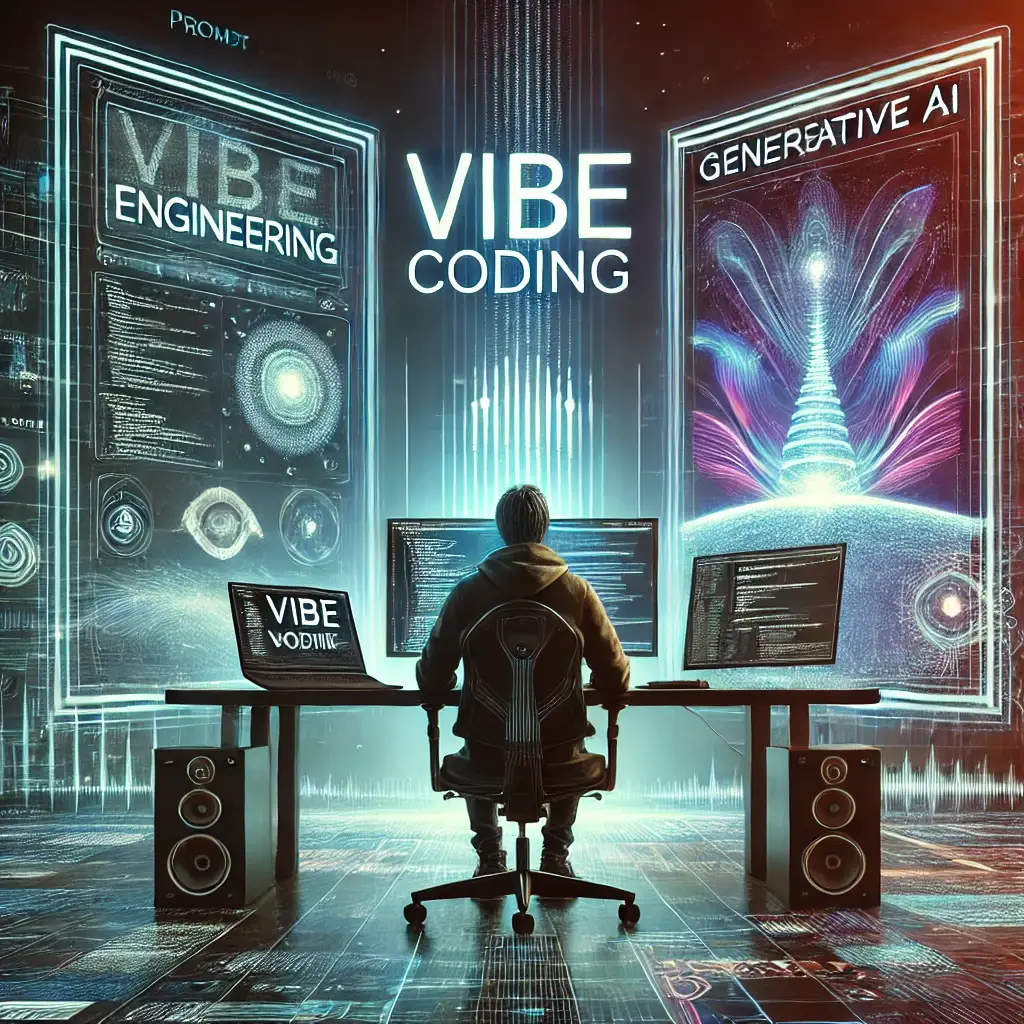
Source: Medium
If you come from a product designer or product management background, it's going to be a lot easier. You can take things pretty far these days just with prompt engineering and vibe coding. I've seen a lot of designers do this as well. The new Manifold website was also vibe coded. That itself is a form of education, where product managers or product designers who weren't studied engineers are now able to build things that they can imagine. It's going to open up a plethora of new apps that people can dream of and just deploy and launch very fast.
Harry: I read an article recently by Andrej Karpathy on vibe coding is the future. I read this article on TechCrunch that a quarter of startups in the latest YC cohort have like 95% of their entire code base done using AI or vibe coded.
Adrian Lai: In the early stage when you're focused on an MVP, you're optimizing more for go-to-market and speed of development. In this stage, vibe coding is great and you're probably resource strapped. You can build with one or two people, a full stack app using Cursor or using Windsurf or using bolt.new or lovable.dev. There's a bunch of tools that you can use to build out a working prototype of your idea, good enough where you can integrate Stripe, you can integrate Privy, and you can start getting users.
If you're thinking about eventually needing to bring on a dev, needing to do DevOps, needing to build a system so that it can scale and have capacity to serve thousands of users or more, then you can also design it in a way that it's flexible and can be scalable. You just have to work with your AI co-pilot to design it in a way that can scale, knowing that at some point you'll probably need to bring on additional engineers and resources. But to get a product to a point of MVP, with the AI tools that we have accessible to us, anyone can do it.
Use Cases for AI Agents in Education
Adrian (Ddream): One thing that comes to my mind is for the very early age conversational education or very early age child. It's very useful for language speaking, but in terms of other subjects, it's not quite useful. We can utilize those agentic workflow or agentic framework to put in the courses and the goals so that during the conversation, the agent will be more focused on the goal to teach rather than just randomly speaking.
Danny: One of the use cases we are researching recently, especially when we started our journey from the incubation course, is how do we let an agent handle all the money and put it on various DeFi protocols to manage a good APY or the best APY that it can possibly accomplish. In our product, we are researching this as a single use case - if we can get tokens and put them into a Pando protocol to manage a good APY when different PT or YT product varies, the APY of it varies. When we are building with this kind of scenario, lots of questions, problems, and concerns came out, such as how do we trust AI to handle those tokens and how do we really trust that AI manages a good or the best APY.
From Idea to MVP: The Roadmap
Adrian Lai: I'd probably start with just writing out the concept in text. Then I'd do some brainstorming with Claude, where you can set up projects so you can give it context. You can grab reference websites, reference mood boards, even scrape websites and get the content or transcripts and stick it into Claude projects and then just go back and forth until you get to a point where you can ask it to create an implementation plan or PRD. Once it's good, then you can put it in Cursor and go off that. That's how I usually go from zero to 0.1.
Danny: For me, the first step would always be doing the research.
💡
When I got an idea, checking it out if someone is doing the same or similar thing. And if not, is your idea a real need and why?
Doing the research to test it out that your idea is a real need and why no one is doing that.
I always talk with people, talking with your target users, your colleagues, your friends in the field to do that research and test it out. After that, I would write down a document including the whole project concept - from concept, overall tokenomics, product market fit assumption, target user marketing, product features. I would write down everything in my mind and talk to people again by using that document. After that, if the answer is yes, I would continue building this product or features.
Jake: I'm not a developer, so I always come at things from more of a marketing angle.
🔥
From my experience, I think the most important thing is even if you only have a single feature, make sure that it's working, that it isn't buggy.
So when users come and test it, that experience is good and they can understand what your product is and what you want them to do.
I would always try and make an effort with your UI. If it looks polished, looks attractive, looks like it's ready for market, you're going to get a better response from people generally. Even at the MVP stage, having a strong vision for what you want the product to be next will help people want to support you more long-term. If they can understand where you want this product to go next, that's really going to help you progress in those early stages and build that core group of initial users that are going to keep coming back and testing with you as you build your product out.
That vision is an important piece and that leads into setting up your social media and having a presence there so that there is a space for your early community to attach to. There's a thing for them to tag and talk about once they have tested your product.
Defining a Realistic MVP Scope
Adrian Lai: I usually think of an MVP as the minimum thing you need to build in order to get the initial feedback. It doesn't necessarily need to be the minimum thing to generate revenue or to generate traction, but ideally it's the minimum thing that you need to build to get initial feedback from some users. From an MVP, you can also think of an MLP or minimum lovable product, where it is smooth and works great.
For me, really narrowing down who your target audience is and what your core value proposition is, and then figuring out what is the one core feature and building that as your MVP, keeping it as minimal as possible.
Danny: Just build as small as possible. When I was first creating my first product many years ago, I only dropped a UI. With that UI, I spoke to my potential target users and got feedback to testify that our ideas and assumptions were correct and just moved on.
Adrian (Ddream): For the realistic MVP scope, definitely no UI. I typically will try to prompt there and trying to connect the different prompts and trying to make the agent work and try the result and do different tests. Basically, I think by simply using DeFi, building a simple agent could work as a starting point to build a realistic MVP with no UI.
Harry: I'm seeing a lot of projects that win hackathons and trying to build out the full MVP in the incubator face this tendency to do two things. One is wanting to build out as many features as possible - having a referral feature, having some type of rewards, some type of point system, having all sorts of features that some may consider as not core features. If we define an MVP as one or two core features, I think it makes sense. I would almost define it as enough of a project that can really test your core feature out - it has enough infrastructure to onboard your first few customers and document some revenue. That's what determines a successful hackathon project versus a project that gets turned into a sustainable business.
When we are planning how to build an MVP or when we're actually building them, factoring the discovery components into setting the scope is super important. On the landing page or UI front, I'm definitely not against having one, but I would say having some type of working prototype, whether it's done by vibe coding or onboarding your first team to finish the project out, having that prototype early and actually discovering users is key. If the landing page helps to convert sales, I definitely think it's worth it. The MVP scope would be converting your first few sustainable, recurring customers that are validating or recognizing the value that you bring to the table.
Lessons and Tips for Builders
Adrian (Ddream): I have one really important lesson learned from working with AI, more specifically, agentic AI. It's quite important to find a balance. If we build an agent, it's basically connecting different prompts, making a logic for the agents to work as an SOP. It's really important to find the balance between the number of tasks you want AI to accomplish described in a single prompt and the number of prompts that compose the agent.
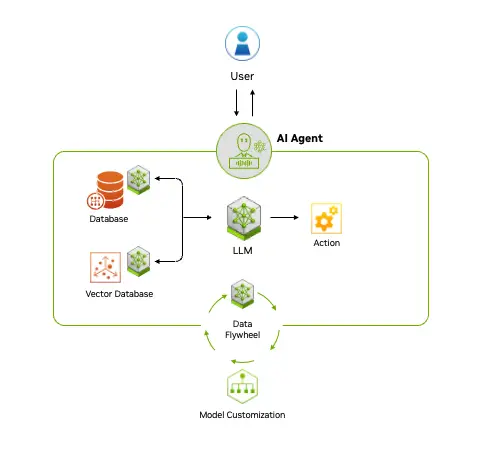
Source: NVIDIA Blog
We need to keep in mind that the more we ask AI to do within one round, the worse the result will be. But at the same time, AI can definitely handle a much better job for a very simple single task. On the other hand, if we divide the task into so many pieces, we will also lose efficiency. It's quite important to find the balance while designing the agent. You don't want to divide them into too many pieces, but at the same time, you want to make sure for each single prompt, you give the AI a very strong one to two points to ask them to complete.
Danny: The most important thing that I learned from the incubator would be to always keep the things you've done in the last week tracked and written down on an Excel. Sean always asks us to write what we have done last week and what our objective is and how we are getting closer to that objective every week. That would help you to track your tasks and keep you always being direct to the goal, the objective that you're targeting. This is not about what you are building with AI or other things. Just as a builder, as a founder, you have to always be focused.
Adrian Lai: In the hackathon context, I would say speed up your research time by scraping as much information as possible. If it's an EDU chain hackathon, get as much context about EDU chain and ideas around EDU chain. Look at what already exists and you can scrape all that, put it into an LLM and really speed up your brainstorming process by scraping context and building up a knowledge base quite quickly where you can then brainstorm ideas off of.
The second point I would say is try to use existing tools as much as possible. The tooling in terms of agent frameworks, both in the Web2 and Web3 space, and also even UI components is quite robust where you can put together a very high quality hackathon project just by connecting various tools to execute an idea. Don't worry if it's a GPT wrapper or anything, because ultimately you just want something that can clearly articulate an idea and a concept.
Jake: I want to echo what Adrian was saying there. Spend some time looking at what the EDU chain ecosystem actually needs. There would be figuring out what problem you are actually solving for education stakeholders. When I talk about education stakeholders, I'm thinking students, teachers, education institutions. Are there any problems that you can solve with AI for this group of people? Because that's essentially what EDU chain is trying to do - solve problems for education using blockchain and other technologies.
Also understanding what AI products are already out there on EDU chain and figuring out where you can either improve on existing products or plug in any gaps that might not actually exist yet. If you need help mapping out the existing products, feel free to reach out to me in DMs, either on Twitter or Discord. I'm happy to run through some of the existing AI products that are already on EDU chain so you can either build off the back of that, or it might inspire a fresh idea.
Top AI Projects on EDU Chain
Jake: We've got quite a few AI projects already. There are content platforms like TinyTap and DailyWiser. These guys are helping people create educational content and learn better.
I know there are a few different agent products coming up as well. I actually saw today Olu has created an AI agent toolkit for EDU Chain. This basically allows Claude to interact with EDU Chain and for developers to spin up all types of agents quite quickly without needing to code. If you are someone that might not be too technical but you still want to spin up an agent on EDU Chain, that would be something to check out.
One that I really like is OpenTask AI. This is a job platform, so it's thinking about how they can create an AI product a little bit differently. This is essentially a platform where freelancers that use AI can find jobs and companies that are looking for these type of freelancers can put up their briefs and their job specs. I think there's no doubt that AI is going to be a part of the future of work and this is a platform that is currently tackling it and trying to connect people up that are using AI with companies that are looking for this type of resource.
There are also some infrastructure products, one called EDU-GPT. This is essentially a chain block explorer that uses an AI chatbot. You can type in any query and it will go and search the EDU Chain blockchain and bring you up the data that you need. That's a really interesting use case. It makes block explorers a little bit more engaging and a fun way to actually look at the data.
We're also starting to see some AIFI or DeFi AI products coming up. There's one called Assetly, which was one of the winners of the previous hackathon now in the incubator. This is essentially like an AI portfolio manager where it will help you manage your crypto, tell you when things are trending upwards or downwards quite quickly and give you advice on what to do with that.
Harry: Another project I really liked was called Infinity Ground. It's also part of Cohort 1 of OCI. Very crack team from TreadFi and also Web3 Native projects from Michelle and a lot of the builders from top companies. They recently closed their seed round to millions and they've been really shipping a lot of new features. They have their first GenTech IDK (Intelligent Development Kits), which includes an IDE, specifically for the entertainment sector. If you are interested in building a game project or some type of entertainment related projects, especially games, feel free to check out Infinity Ground. They have an SDK and a lot of helpful resources there, especially for participating in Semester 3.
What Makes a Perfect Hackathon Submission
Jake:
💥
What I would be looking for when looking at submissions is a working MVP product that maybe even only has a single feature that can prove that it's working and it solves a real problem.
If we're looking at the top ranking submissions, this would be paired with a good team. Solo devs are perfectly acceptable in a hackathon, but if there's already a team behind one of these projects, the judges are just going to look more favorably on that because they know that there's more chance of this team being able to execute it from the MVP to the division they're talking about.
Similarly, solving a real problem in education, either for the EDU Chain ecosystem or real teachers, students, institutions, would be another thing that the judges would be looking for. Obviously, it doesn't have to solve the full problem at MVP stage, but does that MVP have scope to expand into solving real problems in education?
💥
Another thing I personally would be looking for is, does this product have a chance of either grabbing a lot of attention or bringing a lot of TVL to EDU Chain?
I think that'd be two big things that at a chain level we are looking for. We're always looking for more attention and we're always looking for TVL. So does your product that you're starting to build out have potential to achieve either of those two things?
Harry: We actually drafted a blog called "Best Practices for a Successful Web3 Hack Project Submission." At a high level, one is having good documentation. That means having a README file on GitHub that really explains the project well, how it works, what's the tech stack, and if there's any additional information such as contract address or additional features to outline.
Sometimes if you don't include some of those details, people might miss it. They may not capture every single little detail in your video. So if you have a README file that's super easy to follow, that's going to go a long way.
A very important deal breaker would be, for example, not deploying the project, or not submitting GitHub, or not including a contract address. For on-HackQuest, you won't be able to submit a project if it doesn't have at least all this information filled. It has to include contract address, deployments, demo video, pitch video. We actually made it intentionally difficult. You have to spend at least probably 10-15 minutes to even fill some of this info up to be able to have a successful submission.
Another thing that's very important is the functional UI, which is making sure your project is UX friendly and allows people to really interact with it. I know some of you record a pitch video and demo video together, I actually recommend keeping it somewhat separate because the pitch is going to talk more bigger vision. The demo is where you actually showcase the project features. Sometimes your project might have some issue with the website, and if you have a demo video, judges might still be able to give fair evaluation based on that.
Last piece of suggestion is when we're looking at evaluating a lot of projects, having very clear pitch and demo videos is very important. By clear, I also mean short enough. If you do a 30 minute video, and I've seen people uploading 25 minute videos, I would say 5 to 10 minutes is a maximum. At 5 minutes, people will definitely watch the whole thing, and they're more likely to retain some information afterwards.
Adrian Lai: Spend a little bit more time also on the packaging. Echoing what all the other speakers have said, but spend a little bit more time on clarity versus cleverness, making sure it's very easy to understand. Because in a hackathon context, the judges normally have to look through many projects in a short amount of time. So, making sure the concept is articulate and easy to grasp, I think is also an underrated point for hackathon submissions sometimes.
Stay tuned for more online events 👇
